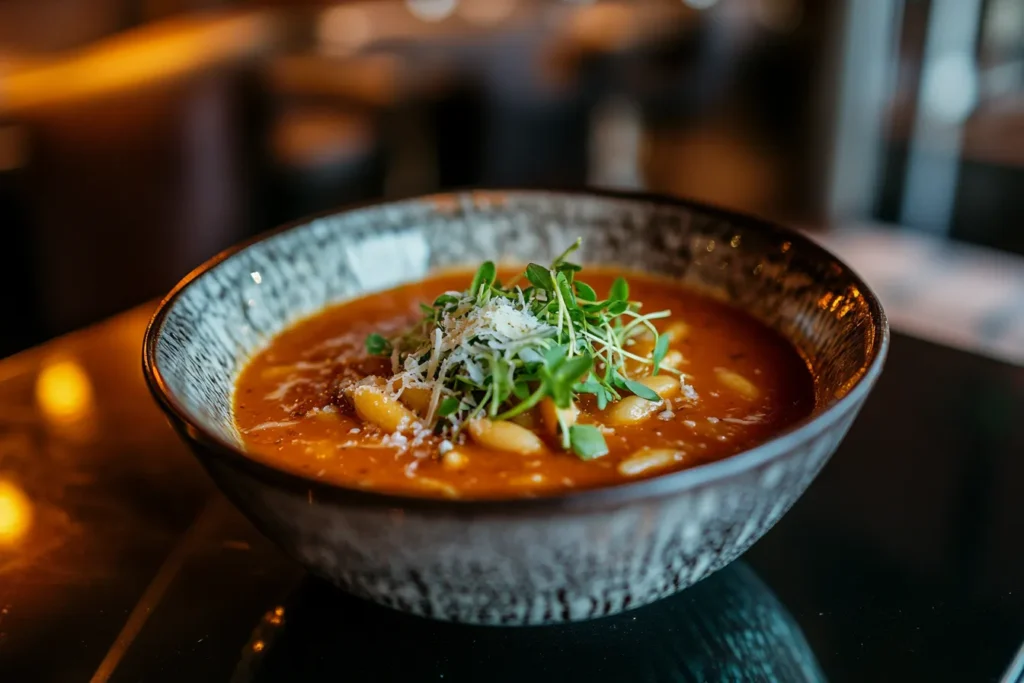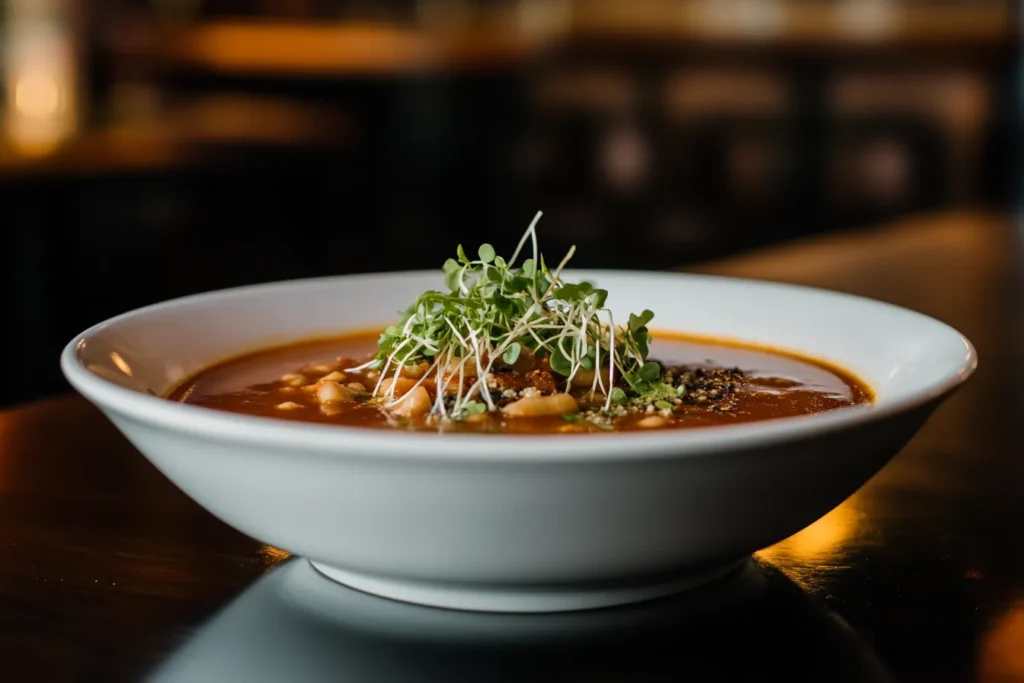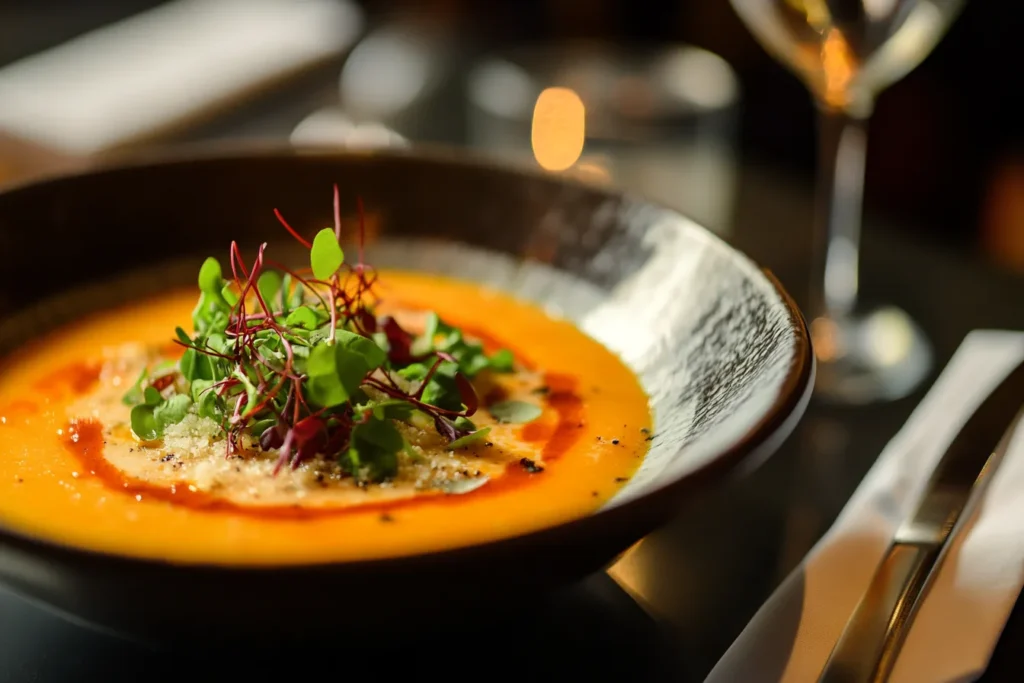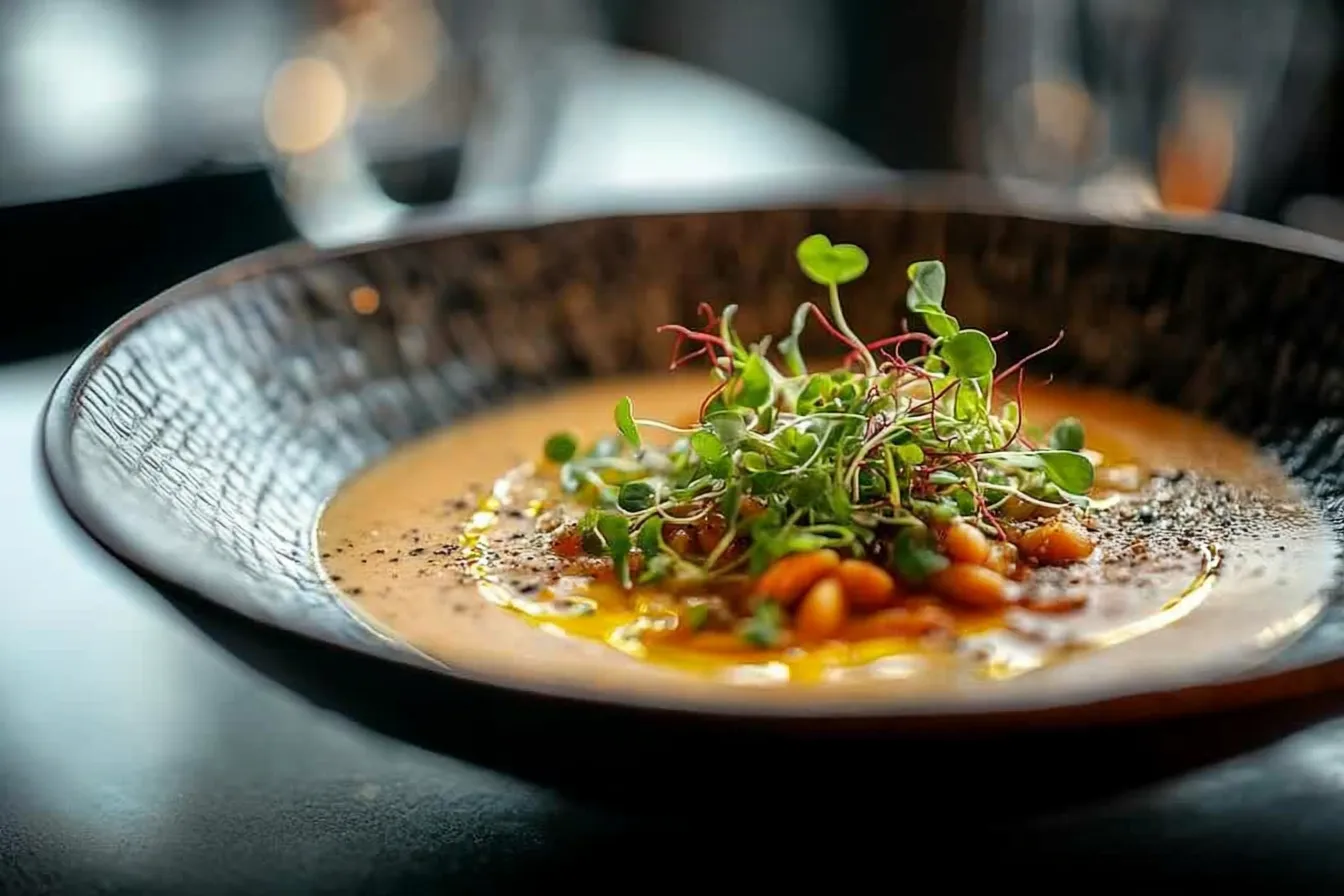Have you ever stared at a menu or recipe and wondered, “What’s the real difference between Pasta e Fagioli and Minestrone?” If so, you’re not alone! Both dishes are undeniably hearty, comforting, and packed with flavor. However, deciding which one to make—or order—can sometimes leave you scratching your head. On one hand, Pasta e Fagioli offers a bean-filled simplicity that’s rich and satisfying. On the other hand, Minestrone is a veggie-packed bowl of goodness that feels both nourishing and vibrant. If you’ve ever debated between these two classics, this guide is here to help! Let’s break it down step-by-step, so you can confidently choose the dish that perfectly matches your cravings and occasion.
List Of Contents
Introduction to Italian Soups
Italy is synonymous with hearty, flavorful cuisine, and soups are a cornerstone of its culinary tradition. From north to south, every region boasts its take on warm, comforting bowls of nourishment. Two classics that have crossed international borders are Pasta Fagioli and Minestrone. These soups are celebrated for their simplicity, adaptability, and depth of flavor.
Pasta Fagioli, meaning “pasta and beans,” is a quintessential example of Italian peasant food. It’s a dish that grew from necessity, using affordable, locally available ingredients to create something both nutritious and delicious. Minestrone, on the other hand, is a vegetable medley—a celebration of abundance and seasonality that can be customized based on what’s fresh and available.
Why are these soups so important in Italian culture? They reflect the Italian ethos of making the most of simple ingredients and gathering loved ones around the table. Whether it’s a creamy bowl of Pasta Fagioli or the hearty, veggie-packed Minestrone, these soups capture the spirit of comfort and togetherness. Check out more recipes here.

Defining Pasta Fagioli
Origins and History of Pasta Fagioli
Pasta Fagioli has its roots in humble beginnings. This dish emerged as a staple for Italian peasants who relied on inexpensive staples like beans and pasta to feed their families. Over time, it became a symbol of Italian resilience and ingenuity, proving that culinary masterpieces don’t require extravagant ingredients. Its origins are linked primarily to southern Italy, though it has since spread throughout the country and beyond. Check out more recipes here.
The defining ingredients of Pasta Fagioli include:
- Pasta: Small shapes like ditalini or tubetti.
- Beans: Traditionally cannellini or borlotti beans.
- Garlic and Onion: A base for flavor.
- Tomatoes: Often used but not mandatory.
- Herbs: Rosemary and thyme add earthy notes.
The dish typically starts with a sautéed sofrito (a mix of onions, garlic, and sometimes carrots and celery), followed by simmering beans and broth. Pasta is added toward the end, ensuring it soaks up the flavors. Variations abound, with some regions favoring a tomato-based broth, while others stick to a creamy consistency derived from blending a portion of the beans. Check out more recipes here.
Defining Minestrone
Historical Roots of Minestrone
Minestrone’s history dates back to ancient Rome, when Italians consumed simple vegetable stews known as puls. Over centuries, as new ingredients like tomatoes and potatoes entered European kitchens, Minestrone evolved into the robust, vegetable-packed soup we know today. Its essence lies in being a catch-all dish, a versatile creation designed to use up what’s in season or on hand. Check out more recipes here.
Key Ingredients and Seasonal Variations
Unlike Pasta Fagioli, Minestrone’s ingredients are far more variable. Some staples include:
- Vegetables: Zucchini, carrots, potatoes, celery, and leafy greens.
- Beans: Often borlotti or kidney beans.
- Pasta or Rice: Optional but commonly added.
- Broth: Can be vegetable or meat-based.
One of Minestrone’s unique traits is its seasonal adaptability. Summer Minestrone may feature fresh zucchini and tomatoes, while winter versions rely on root vegetables like turnips and potatoes. Check out more recipes here.
Delving Deeper into Pasta Fagioli
Origins and Historical Context
Pasta Fagioli’s story begins in the southern regions of Italy, where agriculture and farming defined everyday life. This dish is emblematic of “la cucina povera,” or peasant cooking, a style of cooking that focuses on inexpensive, filling ingredients. During times of economic hardship, families would use dried beans and simple pasta to create a satisfying meal that could stretch to feed many.
As Italian immigrants moved to other parts of the world, particularly the United States, Pasta Fagioli gained international acclaim. It became a comfort food for Italian-American families, retaining its rustic charm while adapting to new palates.The lasting popularity of this dish highlights its classic and universal charm.
Main Ingredients: A Breakdown
The simple yet classic ingredients of Pasta Fagioli come together to deliver a truly satisfying dish. Let’s take a closer look:
- Beans:
- Traditionally, cannellini beans or borlotti beans are used for their creamy texture and mild flavor.
- These beans are not just a source of protein but also lend a rich, velvety consistency to the broth when partially mashed.
- Pasta:
- Small pasta shapes such as ditalini, elbow macaroni, or orzo are popular choices as they blend seamlessly into the soup.
- Some recipes even use broken strands of spaghetti.
- Flavor Base (Soffritto):
- A combination of onions, garlic, celery, and carrots creates the flavorful base.
- The soffritto is gently sautéed in olive oil to enhance its aroma and flavor before incorporating the other ingredients.
- Herbs and Spices:
- Rosemary, thyme, and bay leaves infuse earthy aromas.
- Crushed red pepper flakes may be added for a touch of heat.
- Broth:
- Either a vegetable or meat-based broth can be used, depending on preference.
- Some recipes call for a splash of white wine to enhance the depth of flavor.
Preparation and Variation
The Traditional Method
- Sauté the Soffritto: Start with a blend of olive oil, garlic, and onions, cooking them until fragrant and translucent.
- Add the Beans: Either soaked dried beans or canned beans are added to the pot.
- Simmer with Broth: The mixture is simmered until the beans are tender, allowing the flavors to meld.
- Cook the Pasta: The pasta is usually cooked directly in the soup to absorb the broth’s flavors.
- Top it off with Cheese: Italians often complete the dish with a generous grating of fresh Parmigiano-Reggiano or Pecorino Romano.
Regional Variations
- In northern Italy, Pasta Fagioli is often creamier, achieved by puréeing a portion of the beans.
- Southern versions tend to be more tomato-forward, reflecting the region’s agricultural staples.
- Some modern adaptations include meat, such as pancetta or sausage, for additional heartiness.
Defining Minestrone
Origins and Evolution
Minestrone traces its roots back to ancient Italy, where it began as a simple vegetable stew. Over time, it became a more complex dish as new ingredients from the Americas—like tomatoes and potatoes—were introduced. Unlike Pasta Fagioli, Minestrone lacks a fixed recipe, showcasing the regional diversity of Italian cooking. Each area of Italy has its version, reflecting local ingredients and culinary traditions.

Core Ingredients
What sets Minestrone apart is its ever-changing nature. Its flexibility means no two bowls are the same, but some common elements include:
- Vegetables:
- Staples include carrots, celery, zucchini, spinach, potatoes, and tomatoes.
- Leafy greens like kale or chard are often added for a burst of color and nutrients.
- Beans:
- Borlotti beans or kidney beans add creaminess and protein.
- Lentils and chickpeas are also used in some regional variations.
- Grains or Pasta:
- Short pasta, rice, or barley is often included to make the soup more filling.
- Herbs and Aromatics:
- Fresh basil, parsley, and thyme bring Minestrone to life.
- Garlic and onion are foundational, while bay leaves add subtle complexity.
- Broth:
- Minestrone can be vegetarian, made with vegetable broth, or enriched with chicken or beef stock for a heartier version.
Seasonal Variations
One of Minestrone’s defining characteristics is its seasonal adaptability. It’s a soup that celebrates what’s fresh and local:
- Summer Minestrone: Features zucchini, green beans, and tomatoes, often served warm or even chilled.
- Winter Minestrone: Relies on root vegetables, kale, and potatoes, creating a rich, warming bowl perfect for cold days.
Preparation Techniques
- Layering Flavors:
- Start with a soffritto of onions, carrots, and celery.
- Add ingredients in stages, starting with the hardest vegetables and ending with the tender greens.
- Slow Simmering:
- Minestrone is best cooked slowly to allow flavors to meld and develop.
- A low simmer ensures the vegetables retain their texture while blending harmoniously.
- Finishing Touches:
- A drizzle of olive oil or a sprinkle of Parmesan cheese is the classic way to serve Minestrone.
- For added freshness, many cooks top it with a dollop of pesto.
Key Differences Between Pasta Fagioli and Minestrone
While both Pasta Fagioli and Minestrone share Italian origins and a penchant for heartiness, their differences are significant enough to make each a distinct culinary experience.
Main Ingredients
- Pasta Fagioli: At its heart, Pasta Fagioli is all about the beans. Cannellini or borlotti beans are the star, providing creaminess and protein. The soup also features small pasta shapes like ditalini or elbows, which soak up the flavorful broth.
- Minestrone: In contrast, Minestrone is a celebration of vegetables. While it may include beans and pasta, they play supporting roles to the colorful array of vegetables like zucchini, carrots, spinach, and potatoes.
Texture and Consistency
- Pasta Fagioli typically has a thicker, creamier texture, often achieved by mashing or blending a portion of the beans into the broth.
- Minestrone, on the other hand, tends to have a brothier consistency, especially when packed with chunky vegetables.
Regional Variations
- Pasta Fagioli: Southern Italy’s versions lean toward tomato-based broths, while northern regions like Veneto may favor creamier versions with a mix of pancetta or sausage.
- Minestrone: Northern Italy might feature rice in place of pasta, while southern regions may embrace spicier or lighter versions, reflecting the local produce and climate.
Flavor Profiles and Culinary Experience
The Distinct Flavors of Pasta Fagioli
The flavor profile of Pasta Fagioli is earthy and hearty, with beans providing a creamy base and herbs like rosemary adding an aromatic depth. Garlic and onions create a flavorful foundation, and tomatoes (if included) add a mild acidity that balances the richness of the beans.
Serving styles can vary, with some opting for a drizzle of olive oil or a sprinkle of Parmesan cheese. Crusty bread on the side makes it a complete meal.
The Layered Flavors of Minestrone
Minestrone’s flavors are more dynamic and vibrant, reflecting the medley of vegetables in each bite. Seasonal ingredients mean no two Minestrone soups taste exactly alike. The inclusion of herbs like basil or thyme, combined with a lighter vegetable broth, creates a complex yet refreshing flavor profile.
Accompaniments might include freshly grated Parmesan or a slice of toasted ciabatta, perfect for soaking up the broth.
Cultural and Regional Significance

Importance in Italian Regions
Both soups hold special places in Italian cuisine but differ in their regional associations:
- Pasta Fagioli: More commonly linked to southern Italy, where beans and pasta were staples for the working class.
- Minestrone: A broader representation of Italy’s agricultural abundance, with variations found in every region.
Role in Family Meals
In Italy, soups like Pasta Fagioli and Minestrone symbolize comfort and togetherness. They’re staples of home cooking, often prepared in large batches to feed the entire family.
Global Adaptations
- Pasta Fagioli has been embraced by Italian-American communities, often appearing on menus as “Pasta Fazool.”
- Minestrone has become a global icon, with versions featuring exotic vegetables or even quinoa in health-conscious adaptations.
Nutritional Comparison
Calorie Content
- Pasta Fagioli: Typically higher in calories due to the beans and pasta combination, with a serving averaging around 300-400 calories.
- Minestrone: Generally lighter, especially if it’s vegetable-heavy, with about 200-300 calories per serving.
Nutritional Benefits
- Pasta Fagioli: Packed with fiber and plant-based protein from beans, it’s a great option for vegetarians and those looking to stay full longer.
- Minestrone: A powerhouse of vitamins and minerals, thanks to its diverse mix of vegetables. It’s also low in fat and perfect for those aiming for a balanced diet.
Popular Variations of Each Dish
Creative Takes on Pasta Fagioli
- Spicy Variations: Adding red pepper flakes or chili oil for a kick.
- Meat Additions: Pancetta, sausage, or even ground beef for a richer taste.
- Vegetarian Versions: Using vegetable stock and emphasizing herbs for depth.
Minestrone Adaptations
- Summer Minestrone: Featuring lighter vegetables like zucchini, green beans, and fresh tomatoes.
- Winter Minestrone: Root vegetables, squash, and hearty greens like kale take center stage.
- Fusion Ideas: Incorporating grains like quinoa or barley for a modern twist.
Cooking Tips for Beginners
Step-by-Step Guide to Pasta Fagioli
- Sauté onions, garlic, and celery in olive oil.
- Add beans and vegetable or chicken broth, seasoning with herbs like rosemary or thyme.
- Simmer until beans are tender, then blend a portion for creaminess.
- Add pasta and cook until al dente.
- Finish with olive oil and Parmesan cheese.
Tips for Perfect Minestrone
- Use fresh, seasonal vegetables for maximum flavor.
- Layer flavors by adding ingredients in stages, starting with the hardest vegetables.
- Cook pasta or rice separately to prevent it from overcooking in the soup.
Common Mistakes to Avoid
- Overcooking pasta: It turns mushy if left too long in the soup.
- Under-seasoning: Minestrone and Pasta Fagioli both rely on proper seasoning to shine.
- Using low-quality beans: They’re the backbone of Pasta Fagioli, so quality matters.
Conclusion: Which One Should You Try?
Pasta Fagioli and Minestrone each bring something unique to the table. Pasta Fagioli is perfect for those craving creamy, hearty comfort, while Minestrone offers a lighter, veggie-packed option bursting with freshness.
Your choice might depend on:
- Season: Minestrone for summer; Pasta Fagioli for winter.
- Taste Preferences: Beans and creaminess vs. a vegetable medley.
- Health Goals: Minestrone is lighter, but Pasta Fagioli provides lasting energy.
The best advice? Try both! Each offers a window into Italy’s rich culinary tradition.
FAQs
- What does “Pasta Fagioli” mean? “Pasta Fagioli” translates to “pasta and beans” in Italian.
- Is Minestrone always vegetarian? Traditionally, yes, but it can include meat-based broths or pancetta.
- Can I use canned beans for Pasta Fagioli? Absolutely! They save time and still taste great.
- What pasta works best in Minestrone? Small shapes like elbow macaroni or orzo are ideal.
- Can Minestrone be frozen? Yes, but cook pasta separately and add it when reheating.
- How can I thicken Pasta Fagioli? Blend a portion of the beans or add a small amount of mashed potatoes.
- What’s the best herb for Minestrone? Basil adds a fresh, aromatic touch.
- Are there gluten-free versions of these soups? Use gluten-free pasta or grains like rice in Minestrone.
- Is Parmesan cheese necessary? No, but it enhances the flavor of both soups.
- Which soup is better for weight loss? Minestrone, due to its lower calorie count and higher vegetable content.
